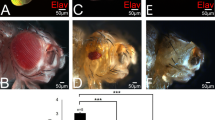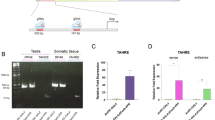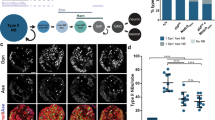Abstract
Although CREB-binding protein (CBP) functions as a co-activator of many transcription factors1–3, relatively little is known about the physiological role of CBP. Mutations in the human CBP gene are associated with Rubinstein-Taybi syndrome, a haplo-insufficiency disorder characterized by abnormal pattern formation4. Recently, we isolated a Drosophila CBP (dCBP) mutant5, and found dCBP to be maternally expressed, suggesting that it plays a role in early embryogenesis. Mesoderm formation is one of the most important events during early embryogenesis. To initiate the differentiation of the mesoderm in Drosophila, multiple zygotic genes such as twist (twi) and snail (sna), which encode a basic-helix-loop-helix and a zinc finger transcription factor, respectively, are required6,7. The transcription of these genes is induced by maternal dorsal (dl) protein (Dl; refs 8–10), a transcription factor that is homologous to the NF-κB family of proteins11–13. The activity of dl is negatively regulated by cactus (cact), a Drosophila homologue of 1κB14. Here, we show that dCBP mutants fail to express twi and generate twisted embryos. This is explained by results showing that dCBP is necessary for dl-mediated activation of the twi promoter.
This is a preview of subscription content, access via your institution
Access options
Subscribe to this journal
Receive 12 print issues and online access
$209.00 per year
only $17.42 per issue
Buy this article
- Purchase on Springer Link
- Instant access to full article PDF
Prices may be subject to local taxes which are calculated during checkout
Similar content being viewed by others
References
Chrivia, J.C. et al. Phosphorylated CREB binds specifically to the nuclear protein CBP. Nature 365, 855–859 (1993).
Kwok, R.P.S. et al. Nuclear protein CBP is a coactivator for the transcription factor CREB. Nature 370, 223–226 (1994).
Janknecht, R. & Hunter, T. A growing coactivator network. Nature 383, 22–23 (1996).
Petrij, F. et al. Rubinstein–Taybi syndrome caused by mutations in the transcriptional co-activator CBP. Nature 376, 348–351 (1995).
Akimaru, H. et al. Drosophila CBP is a co-activator of cubitus interruptus in hedgehog signalling. Nature 386, 735–738 (1997).
Thisse, B., Stoetzel, C., Gorostiza-Thisse, C. & Perrin-Schmitt, F. Sequence of the twist gene and nuclear localization of its protein in endomesodermal cells of early Drosophila embryos. EMBO J. 7, 2175–2183 (1988).
Boulay, J.L., Dennefeld, C. & Alberga, A. The Drosophila developmental gene snail encodes a protein with nucleic acid binding fingers. Nature 330, 395–398 (1987).
Thisse, C., Perrin-Schmitt, F., Stoetzel, C. & Thisse, B. Sequence-specific transactivation of the Drosophila twist gene by the dorsal gene product. Cell 65, 1191–1201 (1991).
Pan, D., Huang, J.-D. & Courey, A.J. Functional analysis of the Drosophila twist promoter reveals a dorsal-binding ventral activator region. Genes Dev. 5, 1892–1901 (1991).
Jiang, J., Ip, Y.T., Kosman, D. & Levine, M. The dorsal morphogen gradient regulates the mesoderm determinant twist in early Drosophila embryos. Genes Dev. 5, 1881–1891 (1991).
Steward, R. Dorsal, an embryonic polarity gene in Drosophila, is homologous to the vertebrate proto-oncogene, c-rel. Science 238, 692–694 (1987).
Ghosh, S. et al. Cloning of the p50 DNA binding subunit of NF-κB: homology to rel and dorsal. Cell 62, 1019–1029 (1990).
Kieran, M. et al. The DNA binding subunit of NF-κB is identical to factor KBF1 and homologous to the rel oncogene product. Cell 62, 1007–1018 (1990).
Geisler, R., Bergmann, A., Hiromi, Y. & Nüsslein-Volhard, C. cactus, a gene involved in dorsoventral pattern formation of Drosophila, is related to the IκB gene family of vertebrates. Cell 71, 613–621 (1992).
Perkins, N.D. et al. Regulation of NF-κB by cyclin-dependent kinases associated with the p300 coactivator. Science 275, 523–527 (1996).
Vortkamp, A., Gessler, M. & Grzeschik, K.-H. GLI3 zinc-finger gene interrupted by translocations in Greig syndrome families. Nature 352, 539–540 (1991).
Hui, C.-C. & Joyner, A.L. A mouse model of Greig cephalopolysyndactyly syndrome: the extra-toesJ mutation contains an intragenic deletion of the Gli3 gene.Nature Genet. 3, 241–245 (1993).
Howard, T.D. et at. Mutations in TWIST, a basic helix-loop-helix transcription factor, in Saethre-Chotzen syndrome. Nature Genet. 15, 36–41 (1997).
El Ghouzzi, V. et al. Mutations of the TWIST gene in the Saethre-Chotzen syndrome. Nature Genet. 15, 42–46 (1997).
Zalokar, M. & Erk, I. Phase-partition fixation and staining of Drosophila eggs. Stain Technol. 52, 89–95 (1977).
Govind, S., Brennan, L. & Steward, R. Homeostatic balance between dorsal and cactus proteins in the Drosophila embryo. Development 117, 135–148 (1993).
Tautz, D. & Pfeifle, C. A non-radioactive in situ hybridization method for the localization of specific RNAs in Drosophila embryos reveals translational control of the segmentation gene hunchback. Chromosoma 98, 81–85 (1989).
Leptin, M. & Grunewald, B. Cell shape changes during gastrulation in Drosophila. Development 110, 73–84 (1990).
Roth, S., Stein, D. & Nüsslein-Volhard, C. A gradient of nuclear localization of the dorsal protein determines dorsoventral pattern in the Drosophila embryo. Cell 59, 1189–1202 (1989).
Nüsslein-Volhard, C., Wieschaus, E. & Kluding, H. Mutations affecting the pattern of the larval cuticle in Drosophila melanogaster. I. Zygotic loci on the second chromosome. Wilhelm Roux's Arch. Dev. Biol. 193, 267–282 (1984).
Chou, T.-B. & Perrimon, N. Use of a yeast site-specific recombinase to produce female germline chimeras in Drosophila. Genetics 131, 643–653 (1992).
Dai, P. et al. CBP as a transcriptional coactivator of c-Myb. Genes Dev. 10, 528–540 (1996).
Jiang, J. & Levine, M. Binding affinities and cooperative interactions with bHLH activators delimit threshold responses to the dorsal gradient morphogen. Cell 72, 741–752 (1993).
Krasnow, M.A., Saffman, E.E., Kornfeld, K. & Hogness, D.S. Transcriptional activation and repression by Ultrabithorax proteins in cultured Drosophila cells. Cell 57, 1031–1043 (1989).
Thummel, C.S., Boulet, A.M. & Lipshitz, H.D. Vectors for Drosophila P-element-mediated transformation and tissue culture transfection. Gene 74, 445–456 (1988).
Nocera, P.P.D. & Dawid, I.B. Transient expression of genes introduced into cultured cells of Drosophila. Proc. Natl. Acad. Sci. USA 82, 1025–1036 (1983).
Author information
Authors and Affiliations
Corresponding author
Rights and permissions
About this article
Cite this article
Akimaru, H., Hou, DX. & Ishii, S. Drosophila CBP is required for dorsal–dependent twist gene expression. Nat Genet 17, 211–214 (1997). https://doi.org/10.1038/ng1097-211
Received:
Accepted:
Issue Date:
DOI: https://doi.org/10.1038/ng1097-211
This article is cited by
-
Stepwise modifications of transcriptional hubs link pioneer factor activity to a burst of transcription
Nature Communications (2023)
-
TIP60-dependent acetylation of the SPZ1-TWIST complex promotes epithelial–mesenchymal transition and metastasis in liver cancer
Oncogene (2019)
-
Epigenetic modifications acetylation and deacetylation play important roles in juvenile hormone action
BMC Genomics (2018)
-
Multiple functions of CREB-binding protein during postembryonic development: identification of target genes
BMC Genomics (2017)
-
NF-κB represses E-cadherin expression and enhances epithelial to mesenchymal transition of mammary epithelial cells: potential involvement of ZEB-1 and ZEB-2
Oncogene (2007)



